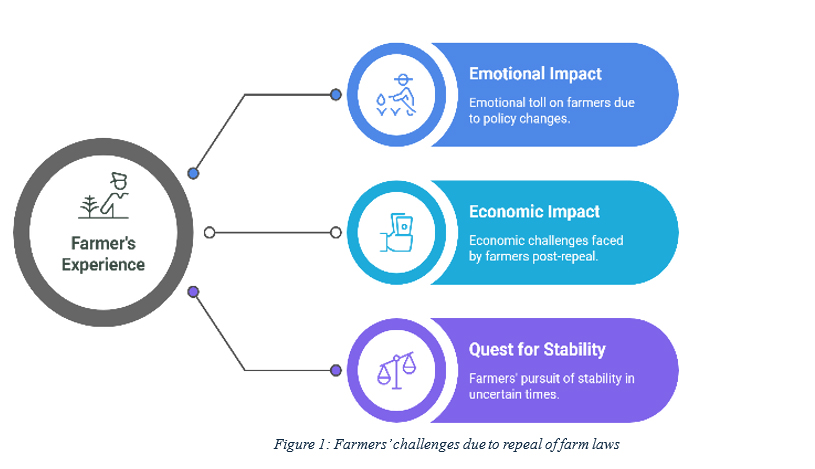
A Farmer’s Diary: Reflections on Our Fields and Future
As the sun rises over my fields, bathing the swaying wheat in golden light, I’m reminded of the hope this land has always held. My family has tilled this soil in Punjab for generations, pouring sweat and dreams into every harvest. Yet today, my heart feels heavy. Three years ago, the repeal of the three farm laws—the Farmers’ Produce Trade and Commerce (Promotion and Facilitation) Act, Farmers (Empowerment and Protection) Agreement on Price Assurance and Farm Services Act, and Essential Commodities (Amendment) Act—was celebrated by many as a moment of solidarity. However, as I walk through my fields, I see the challenges (Figure 1) we continue to face and the potential for reforms to transform our lives.
When the laws were introduced in 2020, they sparked both hope and concern.  They offered to sell my produce beyond the local APMC mandis, connect directly with private buyers, and perhaps secure better prices. While providing stability for some crops, the mandi system has its limitations. In Punjab, market fees, rural development charges, and commissions claim 8.5% of my earnings—about Rs 200 per quintal of wheat. The laws promised to bypass these costs, allowing me to retain more of my income. At the same time, I shared the worries of my fellow farmers: the laws needed stronger safeguards to protect us from potential risks.
They offered to sell my produce beyond the local APMC mandis, connect directly with private buyers, and perhaps secure better prices. While providing stability for some crops, the mandi system has its limitations. In Punjab, market fees, rural development charges, and commissions claim 8.5% of my earnings—about Rs 200 per quintal of wheat. The laws promised to bypass these costs, allowing me to retain more of my income. At the same time, I shared the worries of my fellow farmers: the laws needed stronger safeguards to protect us from potential risks.
Following widespread protests, the repeal in November 2021 highlighted the strength of farmers’ voices and brought national attention to our needs. Yet, returning to the existing system has brought challenges for farmers like me. The mandis remain our primary market, providing stability for wheat and rice crops. Last season, I sold my paddy at the Minimum Support Price (MSP) of Rs 2,060 per quintal, which provides a safety net. But MSP covers only 23 crops, leaving my vegetables vulnerable to market fluctuations. My tomatoes fetched just Rs 10 per kg at the mandi, while consumers in Delhi paid Rs 30. This left me with barely enough to cover costs. Had the laws remained, I might have sold directly to a supermarket or online platform, perhaps earning Rs 20 per kg—an additional Rs 10,000 per ton.
Data paints a broader picture. A 2020 Reserve Bank of India study found that farmers receive only 28% of the consumer’s rupee for potatoes, 33% for onions, and 49% for rice, with the rest absorbed by supply chain intermediaries. The farm laws aimed to address this by opening alternative markets and encouraging private investment in storage and processing. Post-harvest losses, estimated by the Indian Council for Agricultural Research at 5.8–18% for fruits and 6.8–12.4% for vegetables, remain a persistent issue. Last year, I lost 20% of my onion crop to spoilage because the nearest cold storage, 50 km away, cost Rs 5,000 a month—more than I could afford. The Essential Commodities (Amendment) Act could have incentivized private investment in local storage, potentially saving my crop.
The promise of contract farming also resonated with me. In 2020, I grew high-value capsicum for a local buyer, but without a formal agreement, he withdrew when prices fell, leaving me with a Rs 50,000 loss. The Farmers (Empowerment and Protection) Act proposed written contracts with pre-agreed prices, shifting some market risks to buyers. In states like Maharashtra, where contract farming is practiced, small farmers earn 20–30% more per acre than those reliant on mandis. Such systems could mean the difference between financial stability and mounting debt.
The repeal paused a broader transformation. The government’s vision of doubling farmers’ income by 2022 was ambitious, and the laws were a step toward modernizing agriculture. Private logistics, cold chains, and e-commerce investment could create jobs and markets. In 2020, agri-tech startups attracted $1.6 billion in funding, and continued policy clarity could further encourage such investment. My son, who aspires to start a farm-to-fork venture, now talks of leaving for the city, seeing limited opportunity in the current system.
I understand why many farmers protested. The MSP, a critical safety net for wheat and paddy farmers in Punjab and Haryana, felt at risk. The laws didn’t explicitly guarantee MSP outside mandis, and trust in their implementation was fragile. The protests secured the repeal and sparked a national conversation about our future, paving the way for potential reforms.
Watching the sun set over my fields, I pray for rain and resilience. The challenges we face as farmers call for thoughtful reforms that empower us to thrive. Future reforms must couple fair markets that reward quality with robust infrastructure, like local cold storage, to safeguard our harvests. Written contracts with pre-agreed prices can shield us from market volatility, while access to modern technology and training can enhance our productivity. Above all, these efforts must be rooted in collaboration between farmers, policymakers, and private partners, ensuring our voices shape a system that delivers not just crops but dignity and a sustainable future for our families and villages across India.
Author

Connect with Authors at: E-mail agribusiness@sathguru.com
 Grow Beyond
Grow Beyond 

